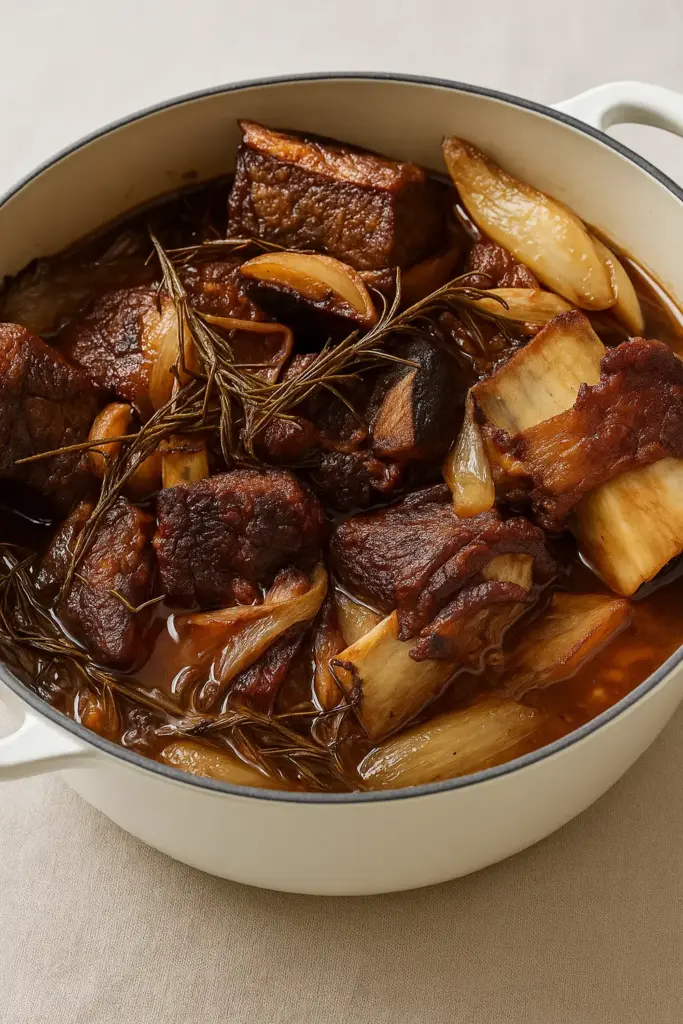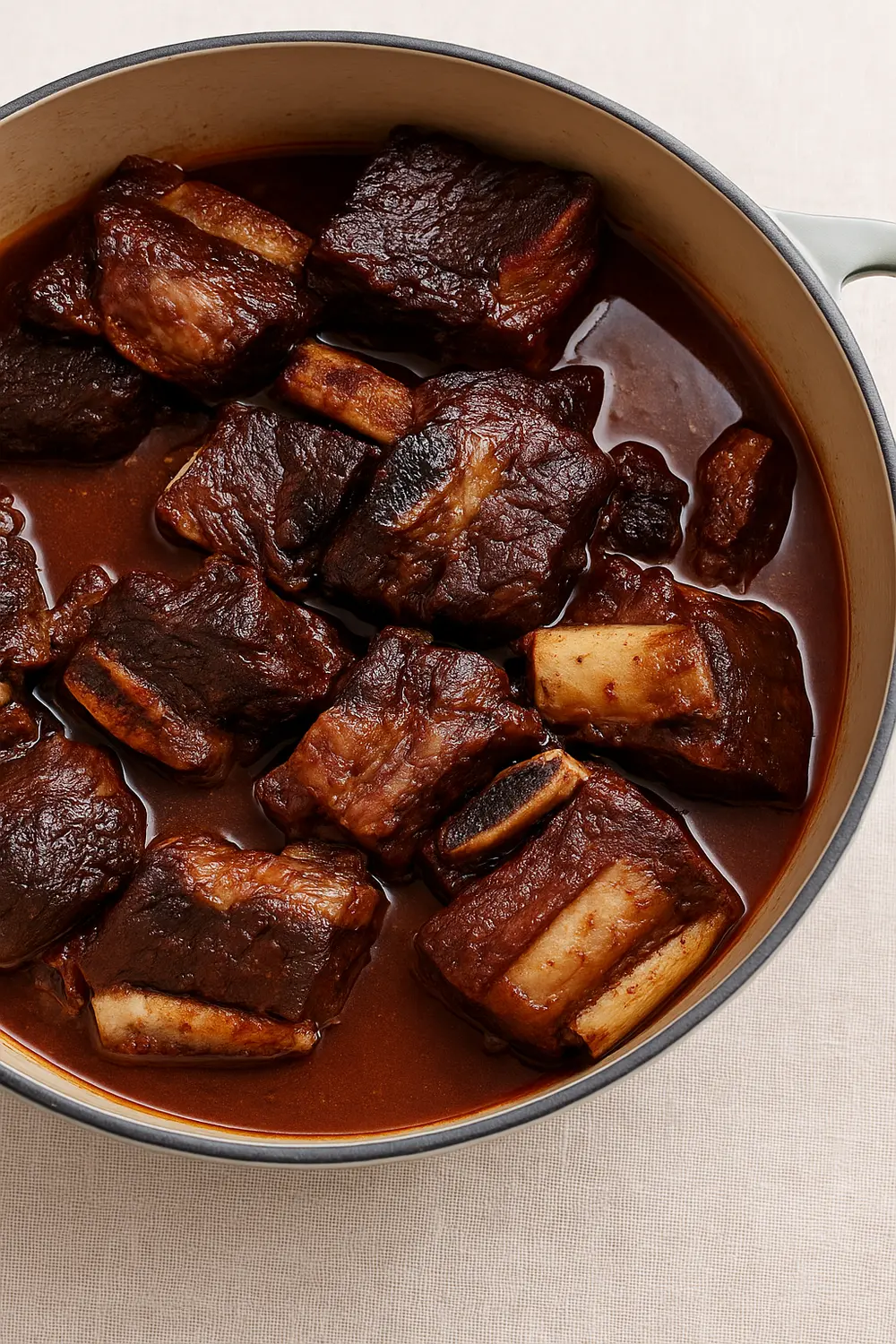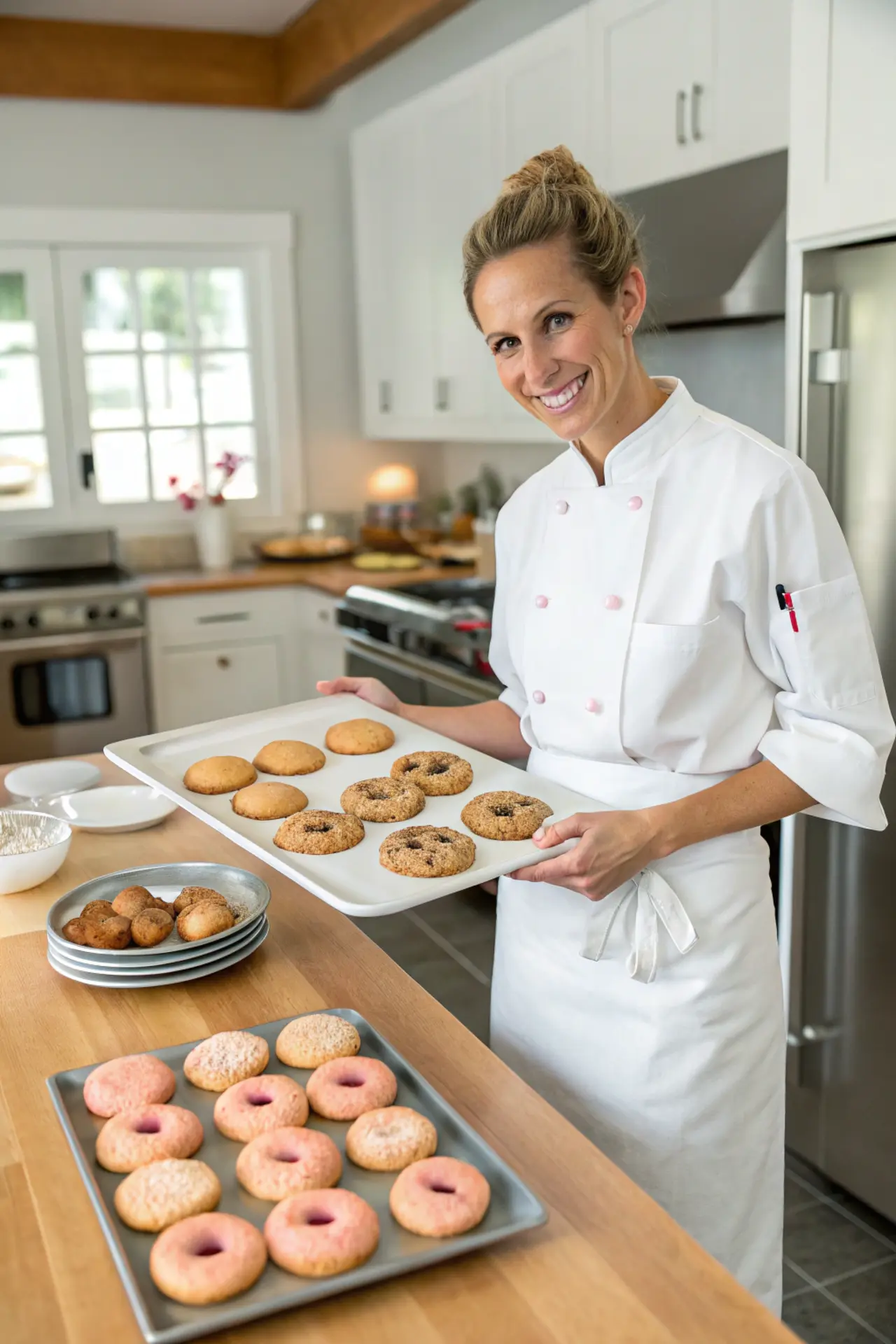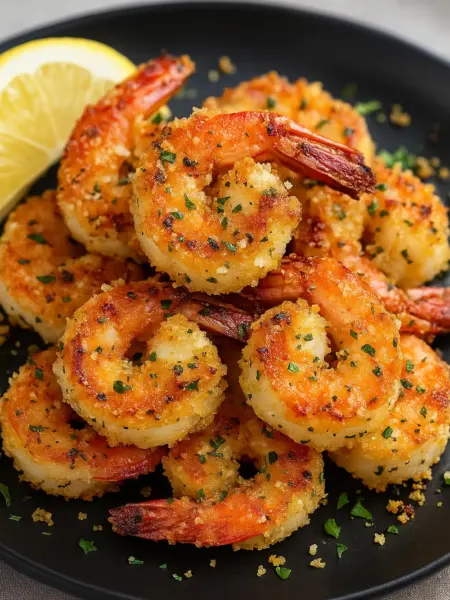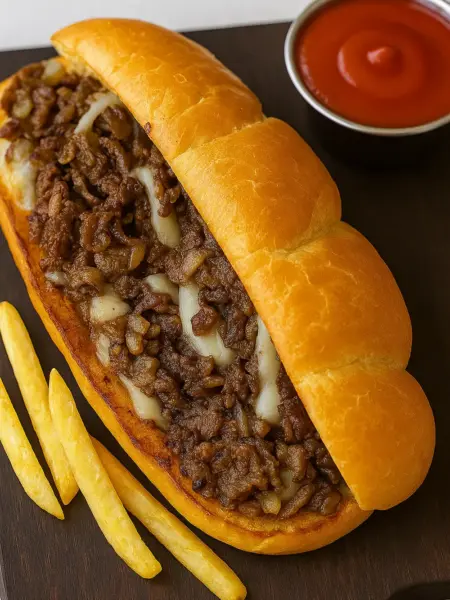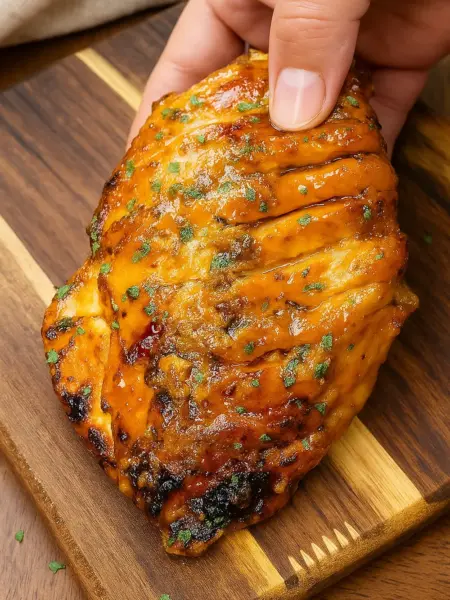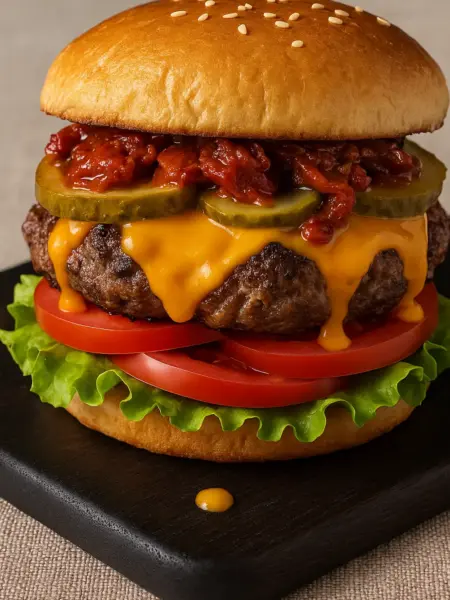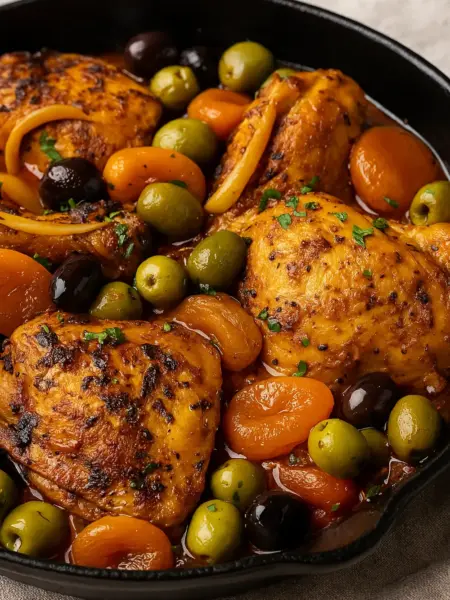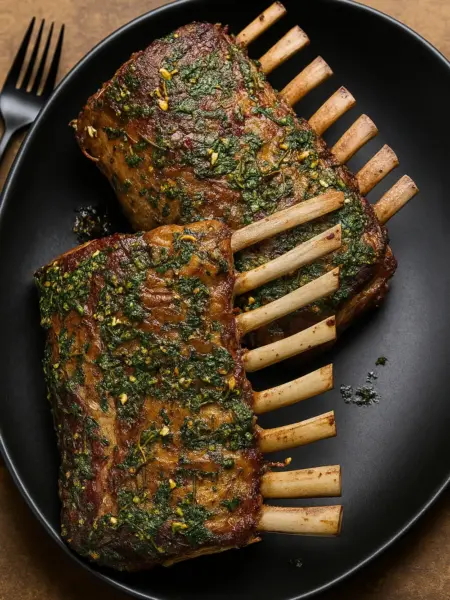This post may contain affiliate links, meaning I may earn a commission if you make a purchase, at no extra cost to you. I only recommend products I trust. Thank you for your support.
Short ribs are a cut of beef from the lower portion of the cow’s rib cage (chuck, plate, or rib sections), and are known for their rich marbling and connective tissue.
Unlike steaks that cook in minutes, beef short ribs thrive with slow cooking methods such as braising, where the meat is gently simmered in liquid until it becomes juicy and melt-in-your-mouth tender.
This easy braised short ribs recipe features tender bone-in, English-cut beef short ribs simmered in a luxurious dry red wine and beef stock sauce infused with herbs and fresh aromatics.
Preparing this iconic dish requires patience, but most of the process is hands-off, as your Dutch oven, slow cooker, or Instant Pot performs its slow, transformative magic.
This slow cooker short ribs recipe is easy to make, serves six, and makes a great centerpiece for Sunday dinners, family gatherings, date nights, or holiday celebrations like Christmas, Easter, and Thanksgiving.
They pair exceptionally well with creamy starches like soft polenta, mashed potatoes, or even wide egg noodles, which are perfect for soaking up every drop of that rich, savory sauce.
✅ Take a moment to read through the whole post for the ingredient list, expert tips, and equipment suggestions. The full recipe is right below.
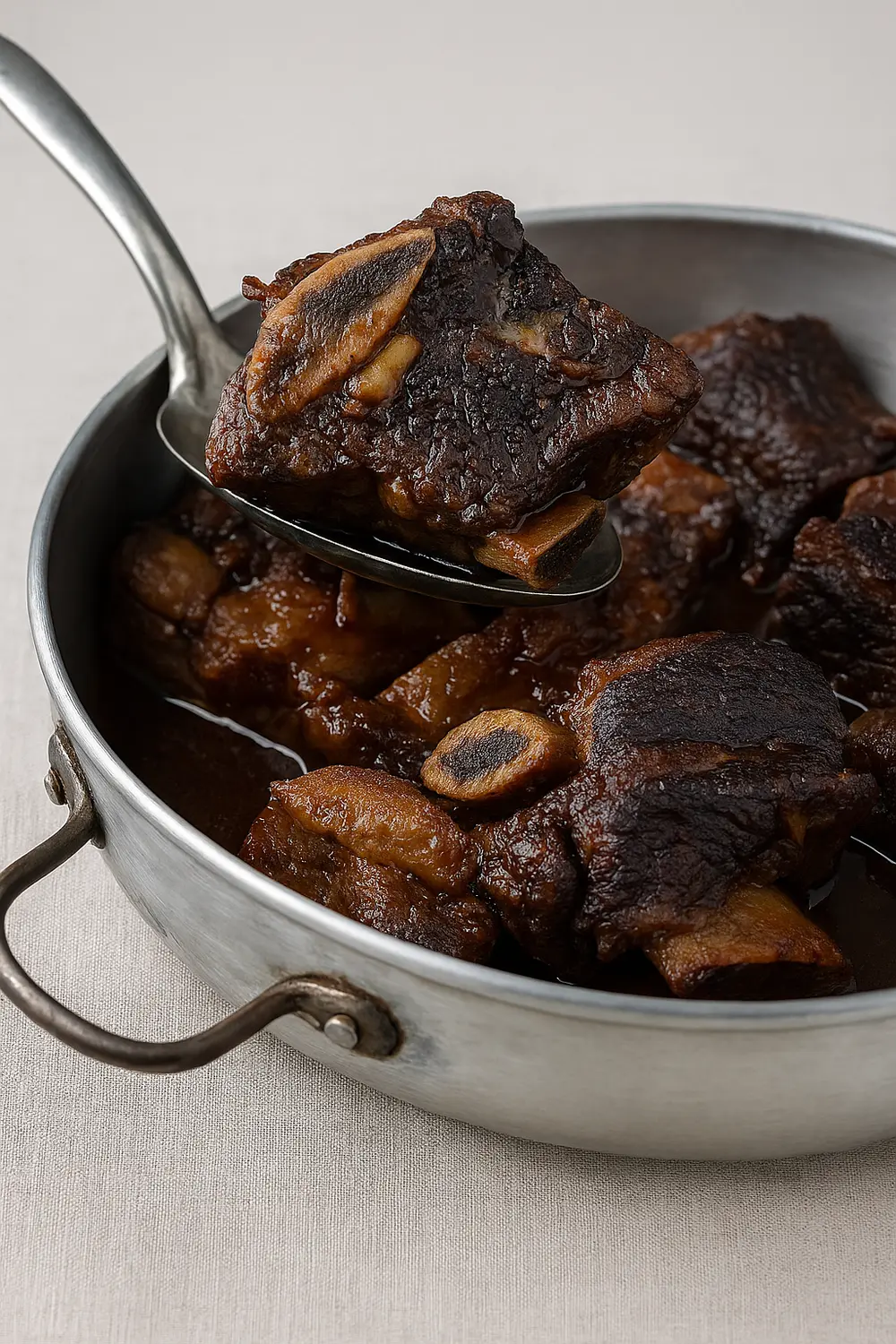
Key Ingredients for This Braised Short Ribs Recipe
The depth of flavor in this classic dish is built on a foundation of professional-grade, quality ingredients, each playing a critical role in the final texture and taste profile.
1. Beef Short Ribs
- Short ribs are rich in connective tissue and fat, making them ideal for braising, as slow cooking gently breaks down the collagen into gelatin, giving them their melt-in-your-mouth tenderness.
- The English cut (pieces cut parallel to the bone, into longer, thicker segments) is recommended for braising, especially bone-in pieces, as the bone adds substantial depth and richness to the braising liquid.
2. Dry Red Wine
- A full bottle of good-quality, dry red wine (such as Cabernet Sauvignon, Malbec, or Pinot Noir) forms the primary flavor profile of the braising liquid.
- The wine’s natural acidity helps tenderize the meat while its complex fruit notes, once reduced and cooked down, transform into a rich, concentrated, savory glaze.
3. Fresh Aromatics
- This classical French aromatic base consists of diced onions, carrots, and celery and forms the flavor base for the braising liquid.
- These vegetables are slowly sautéed, providing foundational sweetness and savory layers to the sauce before any liquid is introduced.
4. Tomato Paste
- Tomato paste provides concentrated umami flavor, color, and richness to the final sauce.
- When sautéed in the pot before adding wine, it deepens the sauce color and taste, giving that restaurant-level richness.
5. Beef Stock and Gelatin
- High-quality beef stock (or sometimes brown chicken stock) provides the necessary moisture for the braise.
- If using store-bought stock that lacks natural body, dissolving unflavored gelatin powder into the cold stock helps create a rich, silky sauce that clings beautifully to the meat.
6. Fresh Herbs
- Fresh herbs like rosemary and thyme sprigs are added whole to the pot, infusing the braising liquid with warm, earthy aromatic layers over the hours of slow cooking.
- Thyme adds a gentle woodiness, rosemary a piney brightness, and bay leaves a subtle peppery flavor that balances the richness.
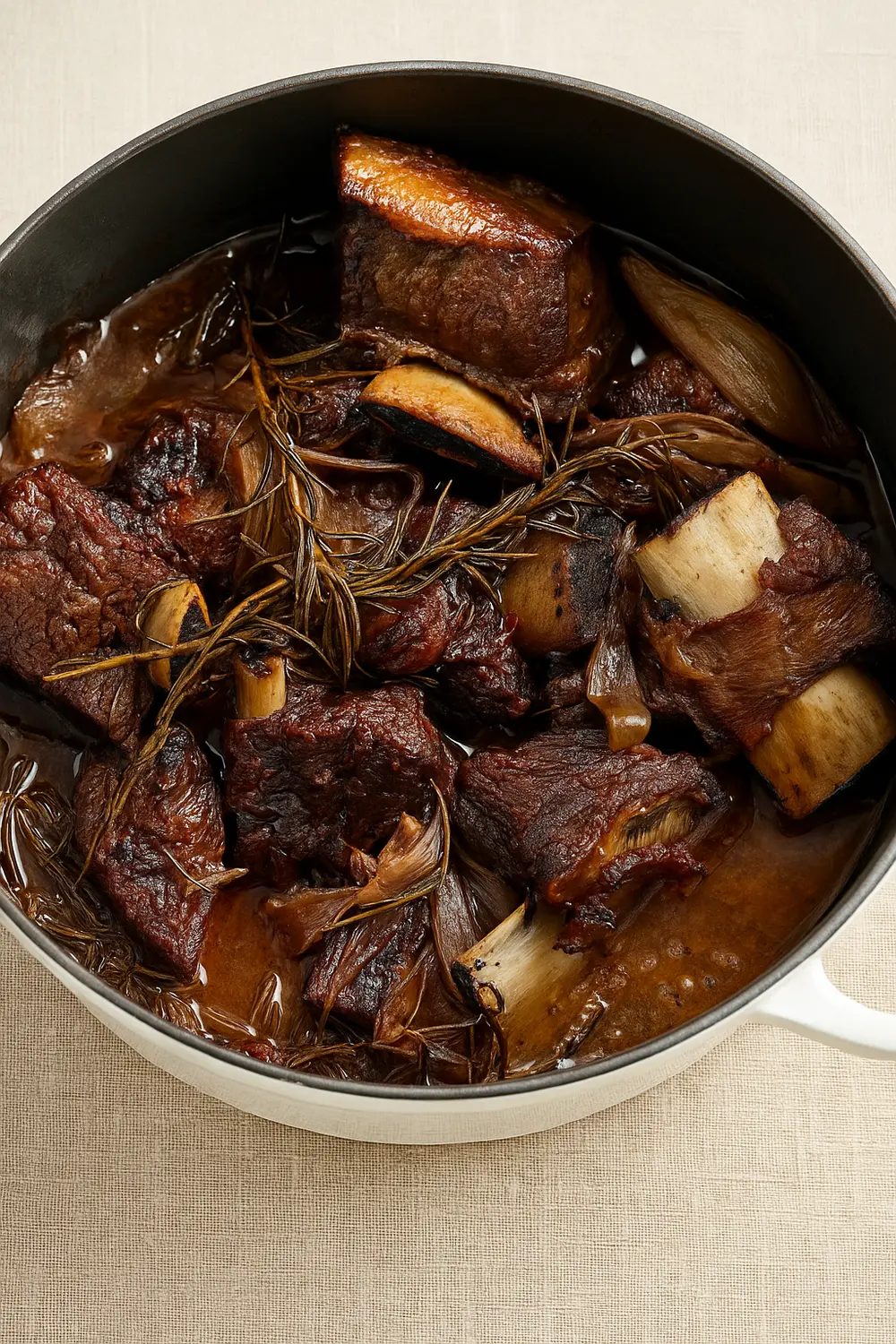
Essential Tools for Making This Braised Beef Short Ribs Recipe
The choice of cooking vessel is key to the success of braising, which relies on consistent, low heat. Here is the necessary equipment you will need for optimal results:
- Cast Iron Dutch Oven: Its heavy construction distributes heat evenly, preventing scorching, and the tight-fitting lid minimizes evaporation while ensuring steam condenses back onto the meat, keeping it moist and tender during the long oven time.
- Heavy-Duty Tongs: Essential for searing the short ribs in hot oil and, later, for carefully removing the extremely tender, fall-apart ribs from the pot.
- Fine-Mesh Sieve or Chinois: Necessary for refining the sauce by straining the liquid after the braise to remove the softened vegetables and herbs, resulting in a perfectly smooth, velvety final glaze.
- Fat Skimmer or Separator: Used to remove the excess fat that renders during braising, ensuring a smooth, rich, and non-greasy sauce.
- Wooden Spoon or Spatula: Ideal for scraping up the browned bits (fond) from the bottom of the pot when adding red wine, releasing all those caramelized flavors into the sauce.
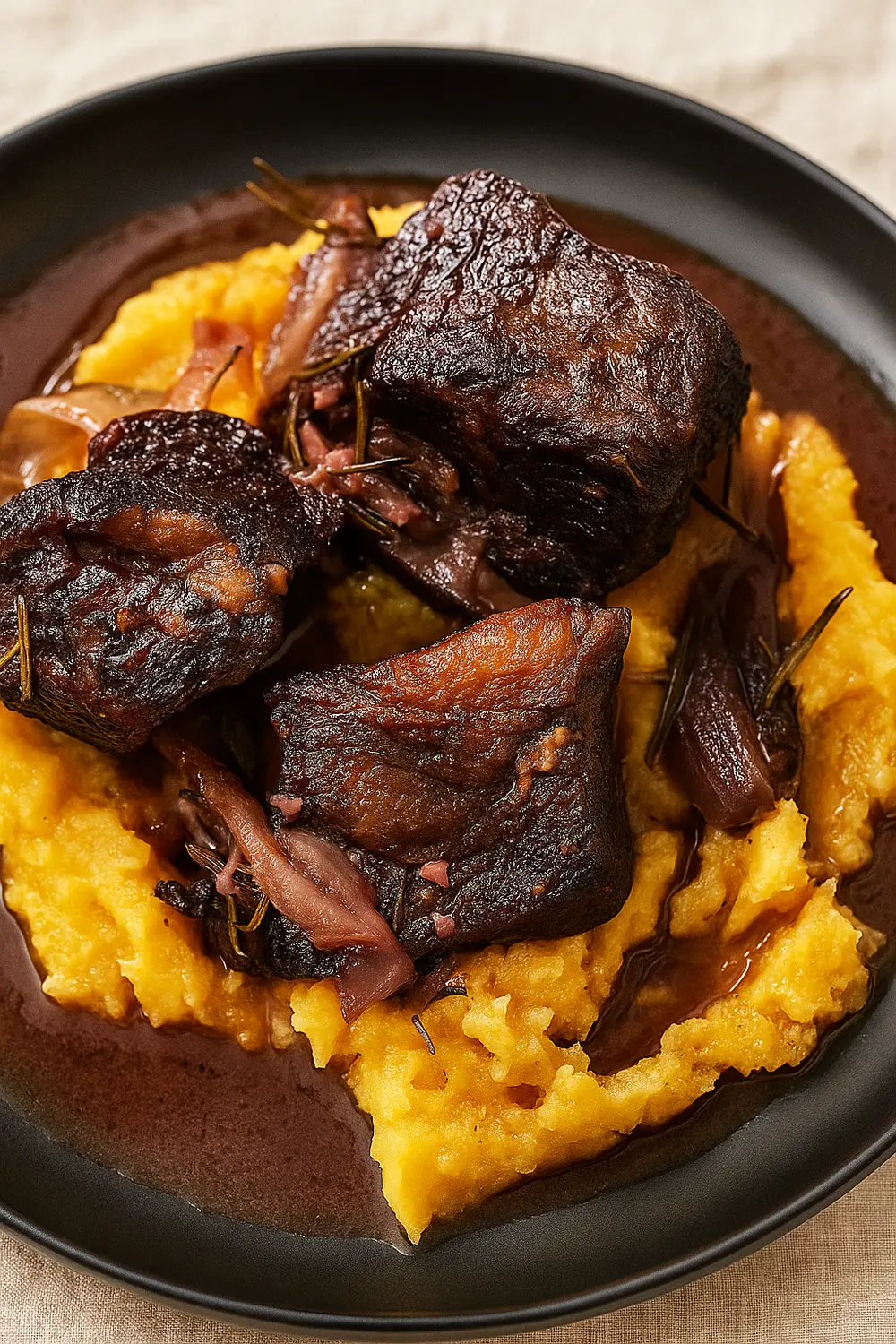
Why You’ll Fall in Love with These Slow Cooker Short Ribs
This particular braised short ribs recipe is beloved not just for its taste, but for the inherent magic of its cooking process and its ultimate dependability:
- The Ultimate Fork-Tender Experience: When executed correctly, the braised beef short ribs will be so tender that the meat literally falls off the bone with a gentle touch from a fork.
- The Perfect Make-Ahead Dish: Slow cooker short ribs taste even better after a day or two, as chilling them overnight in their cooking liquid and reheating later allows the flavors to deepen and meld beautifully.
- Exceptional Source of Protein: Short ribs are high in protein (36g per serving), which is essential for building and maintaining muscle mass, promoting satiety, and supporting overall bodily repair and function.
- High in Heme Iron: Beef is an excellent source of heme iron ( around 5mg per serving), which is vital for preventing fatigue, as it is necessary for oxygen transport in the blood.
- Rich in B Vitamins: Beef short ribs are an excellent source of B vitamins, especially vitamin B12 and niacin, which support nerve function, red blood cell production, and a healthy metabolism.
- Source of Zinc and Selenium: Beef provides valuable amounts of zinc and selenium, with zinc supporting immune health and wound healing, while selenium functions as a powerful antioxidant.
- Collagen and Gelatin: Slow cooking breaks down connective tissue into collagen and gelatin, which may help support joint, skin, and gut health.
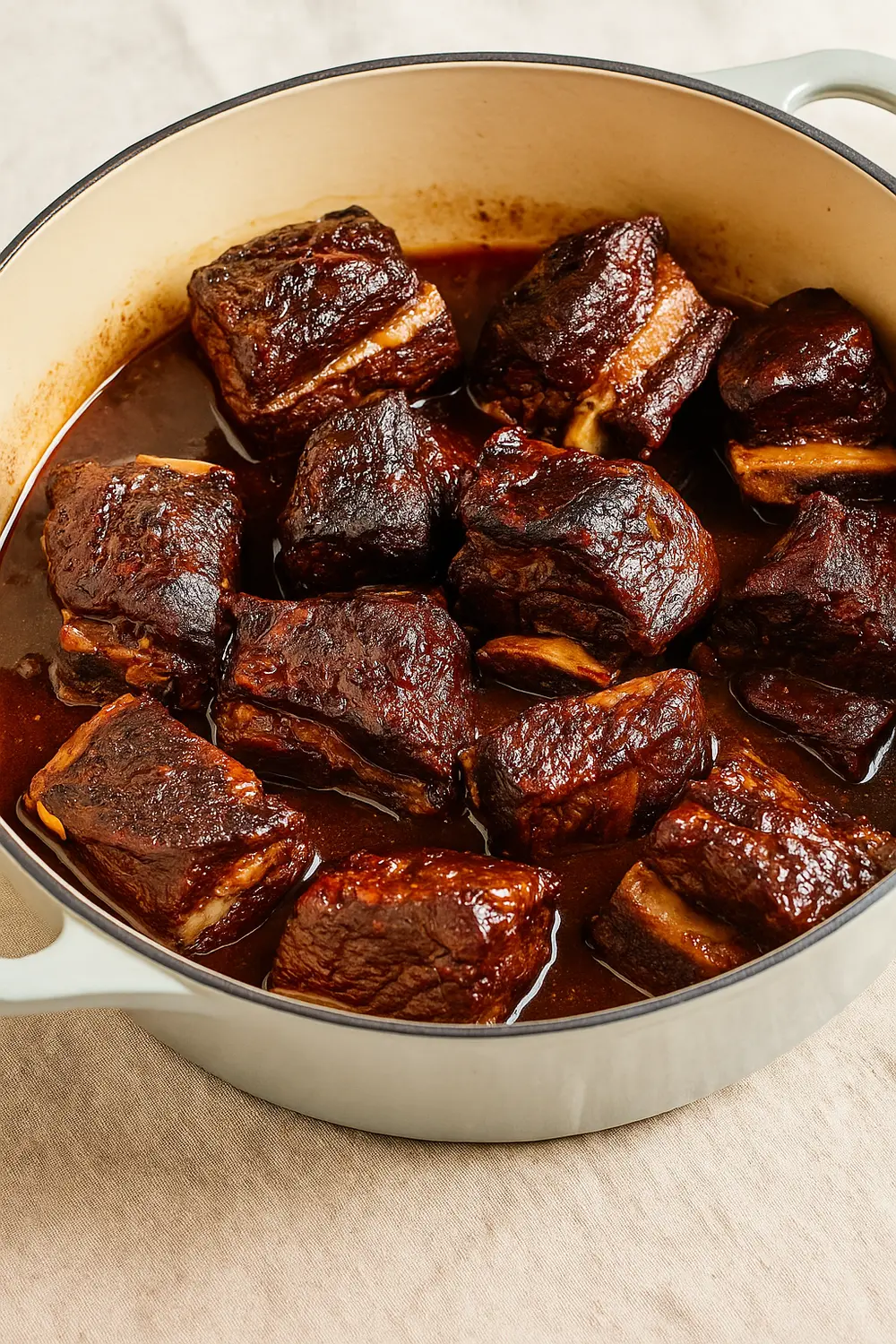
What to Pair or Serve with Red Wine Braised Short Ribs
The intense, concentrated flavor and rich texture of red wine braised short ribs demand side dishes that can absorb the glossy sauce while providing textural and acidic contrast.
- Creamy Polenta: A classic, simple pairing. The fine texture of soft polenta is ideal for soaking up every drop of the rich red wine sauce.
- Garlic Mashed Potatoes: The velvety texture of mashed potatoes provides a comforting, buttery base that balances the richness of the braised short ribs.
- Pappardelle or Wide Egg Noodles: Wide pasta strands, tossed with a small amount of the sauce, create a luxurious, elegant presentation.
- Gremolata: This simple Italian condiment made from finely minced fresh parsley, lemon zest, and raw garlic adds a bright, fresh burst that cuts through the rich, savory flavor of the dish.
- Vegetables: Roasted root vegetables (like parsnips or sweet potatoes) or simple, lightly sautéed greens (like wilted spinach or kale) offer a necessary counterpoint and textural relief.
- Garlic Parmesan Risotto: If you want a show-stopping dinner, risotto with Parmesan and a touch of garlic pairs beautifully with the wine-based sauce.
- Wine Pairing: Excellent choices include a robust Cabernet Sauvignon, an Argentinian Malbec, or a high-tannin Bordeaux blend.
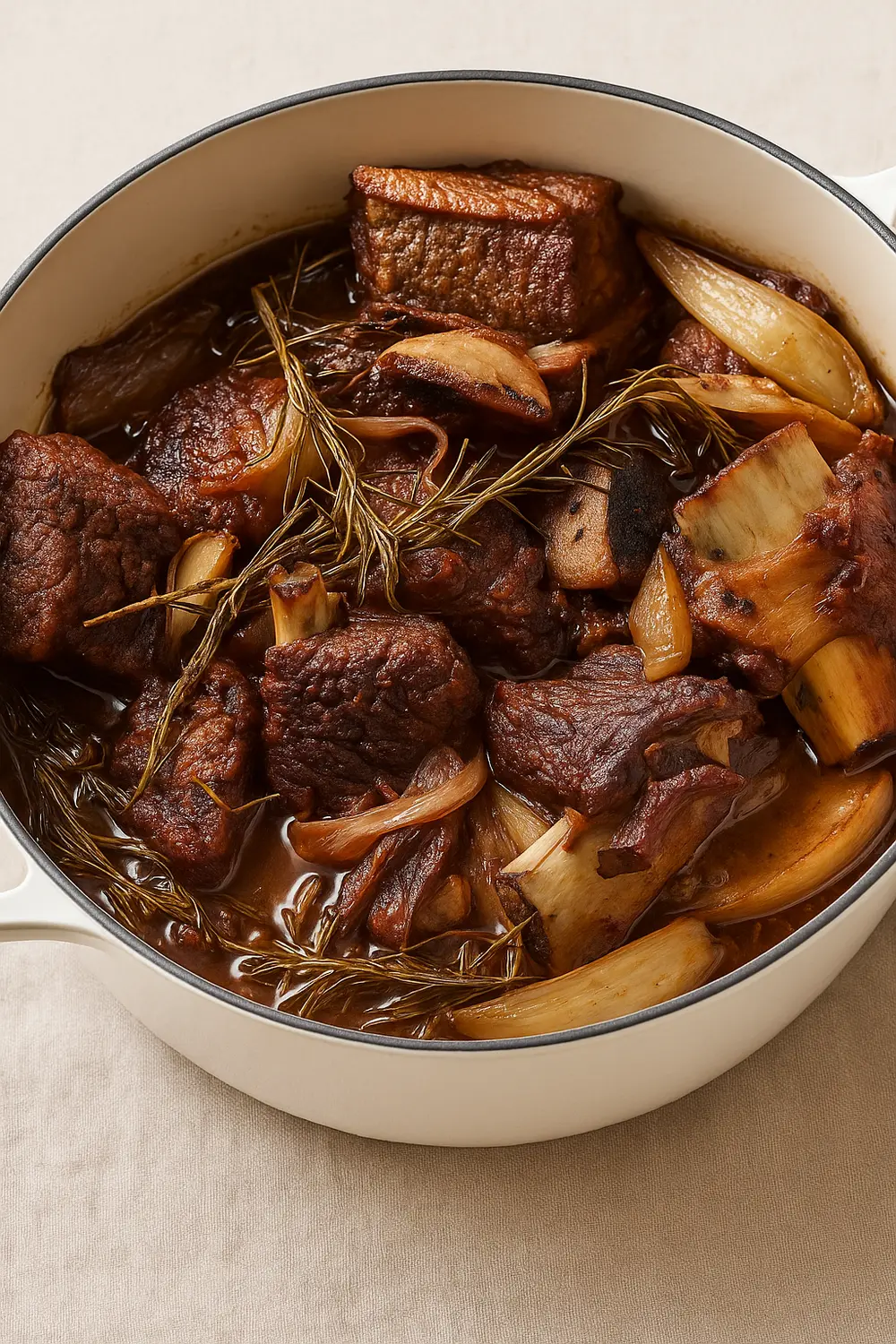
Chef Tips for Making the Best Braised Beef Short Ribs
Achieving restaurant-quality braised beef short ribs involves attention to key professional techniques during the preparation and finishing stages:
1. Season the Day Before (The Dry Brine)
For truly flavorful beef short ribs, season them generously with kosher salt and pepper 12 to 24 hours before cooking and leave them uncovered in the refrigerator.
This process, known as dry brining, allows the salt to fully penetrate the meat, seasoning it deep into the muscle fibers, a much more effective method than seasoning just before searing.
2. Sear Until Too Dark
The deep, dark, mahogany brown crust you achieve on the short ribs creates the fond (the caramelized bits stuck to the bottom of the pot), which provides 90% of the final savory flavor and color.
This intensive searing creates the maximum amount of fond, which is the concentrated source of umami flavor once deglazed.
3. Trim Off the Fat
Always trim any thick, external fat caps from the beef short ribs before seasoning and searing. Leaving this excess fat on leads to a greasy, unpleasant final sauce.
The easiest way to remove excess fat is to cook the dish a day ahead, chill it overnight in the braising liquid, then lift off the solidified fat before reheating and reducing the sauce.
4. Finish with Cold Butter
After straining the braising liquid and reducing it until it coats the back of a spoon, turn off the heat and vigorously whisk in a few cold, cubed pieces of unsalted butter.
This professional technique emulsifies the sauce, giving it a rich, velvety texture and a beautiful, non-greasy gloss.
Final Remarks
This easy braised short ribs recipe brings together everything you love in a comforting yet elegant meal, with tender, fall-off-the-bone beef simmered in a rich sauce infused with red wine, herbs, and aromatics.
It’s the kind of dish that feels special enough for festive holidays or dinner parties yet simple enough to prepare on a quiet weekend.
Serve it over creamy mashed potatoes, buttery polenta, or a bed of soft noodles to soak up every drop of that luxurious sauce.
If you try this recipe, we’d love to know how it turned out! Share your version or let us know your favorite sides in the comments below.
You’ll find the complete recipe and step-by-step instructions just below.
Red Wine Braised Short Ribs Recipe
This classic red wine braised short ribs recipe serves six and features tender beef short ribs slowly cooked in a rich red wine sauce with herbs, onions, and garlic for a luxurious, comforting dinner.
Ingredients
For the Beef
For the Braising Liquid
How to Cook Beef Short Ribs (Step-By-Step Instructions)
Prepare and Season the Beef
- Trim any thick outer fat from the beef short ribs.
- Pat them dry with paper towels to ensure a good sear.
- Season them generously with Kosher salt and freshly ground black pepper.
Sear the Beef Short Ribs
- Heat the Dutch oven over high heat and add the olive oil.
- When the oil is shimmering, sear the short ribs in batches, turning until all sides are deeply browned.
- The searing takes about 2 to 3 minutes per side.
- Once seared, remove the beef short ribs and transfer them to a clean plate.
- Pour out most of the rendered fat from the pot, but leave about 2 tablespoons to use for cooking the aromatics.
Sauté the Aromatics
- Reduce the heat to medium-low.
- Add the diced onions, carrots, and celery to the residual fat in the pot.
- Sauté for 5 to 8 minutes, stirring occasionally, until the vegetables soften and become golden and translucent.
- Next, add the smashed garlic and the tomato paste.
- Cook, stirring constantly, for 1 to 2 minutes until the tomato paste deepens in color.
Deglaze with Red Wine
- Pour the entire bottle of dry red wine into the pot.
- Increase the heat to high.
- Immediately scrape up any brown bits from the bottom of the pot.
- Let the wine simmer for about 5 minutes to reduce slightly and cook off the raw alcohol aroma.
Add Stock and Herbs
- Sprinkle the unflavored gelatin powder over the cold beef stock and let it sit for about 5 minutes to bloom.
- Return the seared short ribs to the Dutch oven, nestling them among the vegetables.
- Add the bloomed beef stock, bay leaves, dried mushrooms (if using), thyme, and rosemary sprigs.
- The liquid should cover the ribs about two-thirds of the way up.
Braise Low and Slow
- Cover the Dutch oven with its lid and transfer it to a preheated oven at 300°F (150°C).
- Braise for a total of 3 hours and 30 minutes, until the meat is tender and easily pulls away from the bone.
- Check occasionally to make sure the liquid level stays consistent and add more stock if needed.
Skim and Reduce the Sauce
- Once the ribs are tender, carefully remove them from the pot and set aside.
- Strain the braising liquid through a fine-mesh sieve, discarding all the solids.
- Return the sauce to the pot and simmer over medium-high heat until it reduces to a thick, glossy consistency, about 10 to 15 minutes.
- Remove from the heat and whisk in the cold, cubed unsalted butter until the sauce becomes smooth, velvety, and shiny, a classic monté au beurre finish.
- Taste and adjust the seasoning with kosher salt and freshly ground black pepper.
- Return the braised short ribs to the pot, spooning the rich red wine sauce over them to glaze before serving.
Serve and Enjoy
- Place the short ribs over mashed potatoes, polenta, or your favorite side.
- Spoon that luxurious sauce over the top and sprinkle with fresh parsley.
- Serve warm and enjoy every bite.
Nutrition Facts
Servings 6
Serving Size Approximately two thick beef short ribs
- Amount Per Serving
- Calories 425kcal
- % Daily Value *
- Total Fat 18g28%
- Saturated Fat 8g40%
- Cholesterol 155mg52%
- Sodium 460mg20%
- Potassium 815mg24%
- Total Carbohydrate 12g4%
- Dietary Fiber 2g8%
- Sugars 4g
- Protein 36g72%
- Vitamin A 135 IU
- Vitamin C 6 mg
- Calcium 80 mg
- Iron 5 mg
* Percent Daily Values are based on a 2,000 calorie diet. Your daily value may be higher or lower depending on your calorie needs.
Note
- Trimming the thick external fat cap from the beef short ribs is essential, as skipping this step will leave you with a greasy sauce that overpowers the dish’s natural richness.
- Searing is essential because the deeper the brown crust, the richer the sauce, so aim for a dark sear rather than a light golden color to build deep, savory flavor.
- Maintain a low braising temperature between 300°F and 325°F, keeping the liquid at a gentle simmer rather than a boil, as high heat can dry out the meat before the collagen breaks down.
- Always strain, skim, and reduce the braising liquid before serving to remove the aromatics, skim excess fat, and reduce the sauce to achieve a smooth, glossy, restaurant-quality finish.

